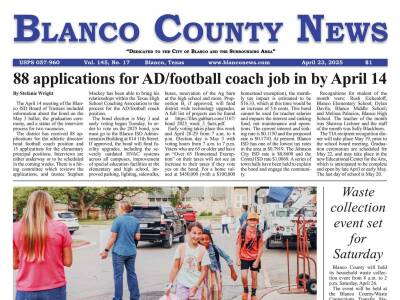main road between Blanco and Wimberley was once the hub of Fischer, a tiny Hill Country community. Fischer is one of those places where one can still touch and smell 19th century Texas. For how much longer, is anyone’s guess.
Hermann Fischer, the man who started it all, left Germany rather than submit to compulsory military service. He arrived in Carlshafen (Indianola) in 1852.
He first settled on a farm along Geronimo Creek above Seguin.
Farming can be a fine occupation when mother-nature cooperates. That year she didn’t. Fischer survived one of the driest spells in recent memory by doing odd jobs around Seguin.
On the boat from Germany Hermann met Anne Lindemann. A Fischer family story says the Lindemanns settled in Blanco. When Hermann went to see her, he was awestruck by the hills, the spectacular vistas, the stately cypress trees, and the soft green water of the Guadalupe and Blanco Rivers.
“There was an Indian trail through here,” recalled Gertrude Fischer, “with grass up to a cow’s belly. And there was water. It looked like a nice place to settle, so he did. He thought it was paradise.”
In 1853 he took up a claim just west of the Devil’s Backbone. His brother Otto soon joined him.
In 1855 Hermann married Anne Lindemann.
Hermann Fischer wanted to farm, but when he tried to sink a plow into the paper-thin Hill Country soil, he decided ranching was a better option.
Of course, ranching wasn’t much better in those days of the open range. When Fischer’s livestock scattered like dandelion seeds in a cyclone, he opened a store.
Over the years the store expanded. Fischer’s inventory included farm implements, hardware, dry goods and groceries. He added a saloon in back of the store.
Fischer was an eternal optimist with unlimited faith in human nature. He had to be. He was a frontier merchant who did most of his business on credit.
The area around the store, originally called Fischerdale, became known as Fischer Store. By the mid-20th century, it was just Fischer.
When his neighbors asked him to open a post office, he politely said “Nein Danke.” He barely had enough time to run the store and saloon. He finally agreed to open a post office and serve as postmaster but only because no one else would do it.
Even then the arrangement almost collapsed when postal inspectors told Fischer that regulations would not allow a post office in the same building with a saloon. The saloon would have to go.
Fischer told the inspectors that if the government didn’t like the post office in the same building with a saloon, it was free to find a new post office and postmaster. He then excused himself saying he had a beer keg to tap.
Under the circumstances the postal service inspectors took drinks on the house and went on about their business. Fischer’s Store became the only post office in the country connected to a saloon.
In 1892 a one-eyed carpenter named Mr. Kloepper built the dance hall that still stands not far from the store and the Fischer nine-pin Bowling Club.
Fischer Store had the first telephone in the area. The phone enhanced the store’s popularity and cemented its reputation as the local center for rumor, gossip and intrigue.
When the Great Depression hit, Fischer Store had thousands of dollars in credit on the books. Most people couldn’t pay, and the debts were eventually cancelled. Even then the business came out of the depression debt free and in good financial shape.
Generation of Fischers came and went but the store changed little until it closed in the 1980s.
Today Fischer still seems distant from the modern world, but the hills are subdividing at a rapid rate. The area is prime real estate. Housing developments are closing in on Fischer like Santa Anna’s army at the Alamo.
Everyone should see Fischer, but don’t wait too long.



